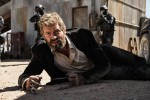The worst part about looking up to heroes is watching them fall.
Inspired by the 2008 comic “Old Man Logan,” the latest Wolverine film “Logan” features an older, slowly dying Wolverine (Hugh Jackman) whose powers are failing. Unlike the flashy and often convoluted films in the “X-Men” franchise, “Logan” is a highly focused exploration of the character that is as steeped in emotion as it is in blood.
Set in 2029, Wolverine’s alias James Logan Howlett has put his heroic days behind him and works as a limo driver with a fondness for alcohol. His only connection with his old life is with Charles Xavier (Patrick Stewart) who has a debilitating brain disorder and needs constant care. James’ relatively quiet life is disrupted when young mutant girl Laura (Dafne Keen) enters his life, and mercenaries hunt the three down.
“Logan” is only a superhero movie in the sense that its characters have powers, and perhaps that is where its greatest strength lies. Rather than devoting resources to scenes full of computer generated imagery or trying to cram as many characters as it can, “Logan” keeps its action centered on its bloody brutality.
The small cast of characters allows for a sense of intimacy that previous installations of the series were unable to capture. With the recent influx of superhero films, “Logan” stands out in that watching it feels more like an action drama than a standard superhero film.
The film’s R-rating allows for a more brutal exploration of the character than previously explored, and each fight scene is a bloodbath. Logan’s jaded rage is matched by Laura’s unchecked ferocity, making the two a delightfully deadly pair. Every fight scene is exciting and finds new ways to torture Logan and his foes. “Logan” is excellently paced and every scene is exciting and relevant because of the actual combat, chase scenes and suspense that the group might get caught.
But even more than the action, the emotional current carries the film. Age has taken its toll on Logan and Charles, and it’s heartbreaking to see Charles so dependent on medication and Wolverine go from a man who saved the world to a limo driver. Though the characters are familiar, “Logan” presents new sides of them, like the depth of Logan and Charles’ regard for each other and or the inner turmoil the two feel for the deaths they have caused.
Jackman and Stewart elevate their characters by reaching emotional depths previously unavailable to them because of overcrowded storylines and too little screen time. While Logan’s conflicted emotions and dark past have been evident since the first film, his newfound alcohol addiction and thoughts of suicide betray a man at the end of his rope.
Jackman imbues older Logan with a vulnerability and weariness that is a refreshing contrast from the traditional cocky brawler version of the character and a painful reminder that even the greatest of heroes can get old.
Stewart’s Charles Xavier is no longer a professor but an old man with a disease, whose seizures emit dangerous brainwaves that cause mass paralysis and death. He is incapable of taking care of himself as he once did. His desperation to save Laura and his discomfort at his helplessness make for a moving performance evoking a mixture of compassion and empathy.
Years of working together have allowed the two actors to develop an understanding that creates a believable and enjoyable father-son chemistry – for example, when Logan berates Charles for not taking his medicine. Nostalgia plays a large role in the appreciation of the film; since both Jackman and Stewart are retiring from their roles, the film takes a higher meaning by saying goodbye to the characters and the actors.
As Jackman’s final ride as Wolverine, “Logan” is everything fans could ask for, a tour de force that expands on the character’s violence and cynicism.
Rather than a mindless hero flick, “Logan” tells a rich story that treats its aging heroes with dignity while maintaining the thrilling action fans have come to expect from superhero films.
